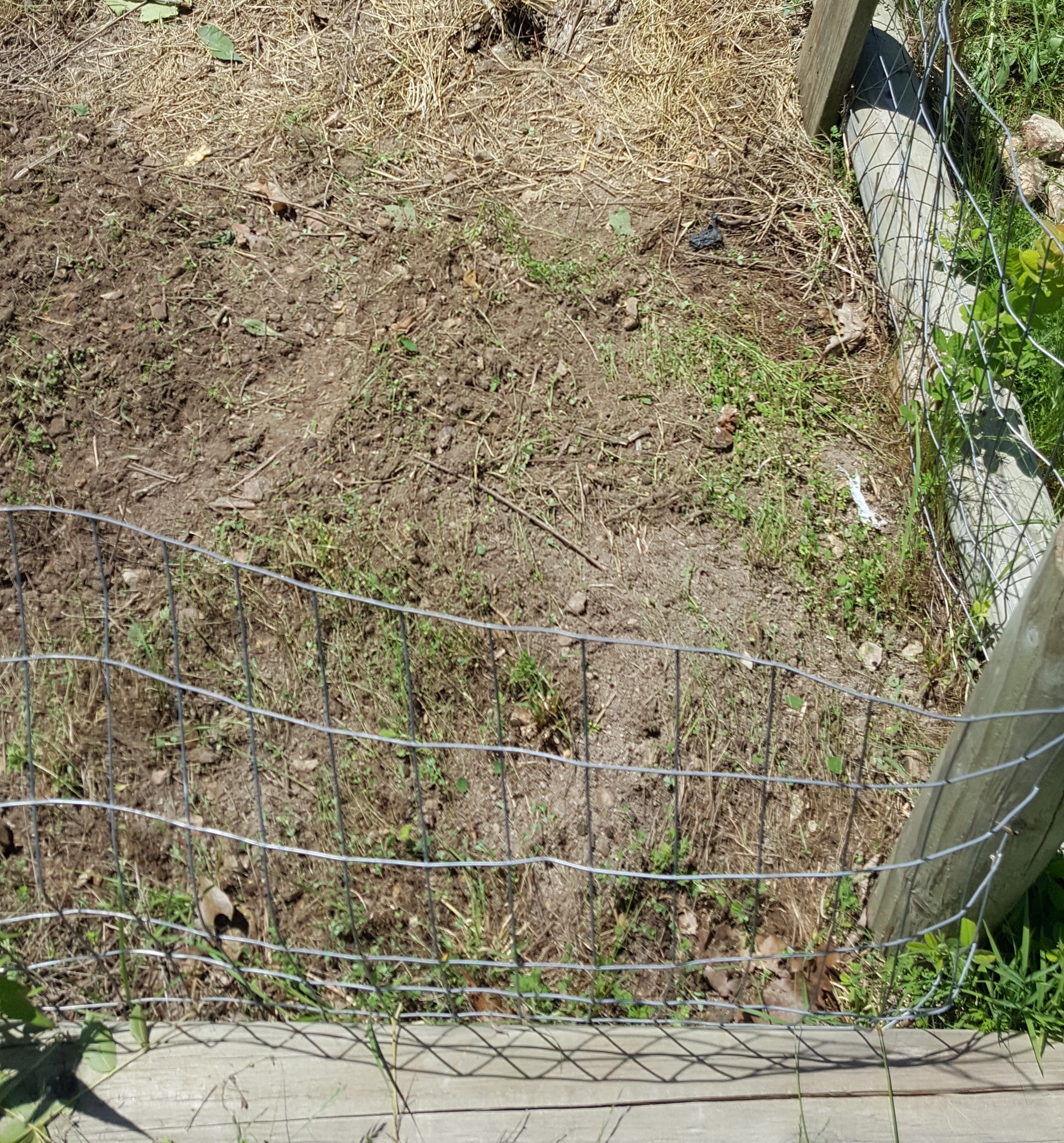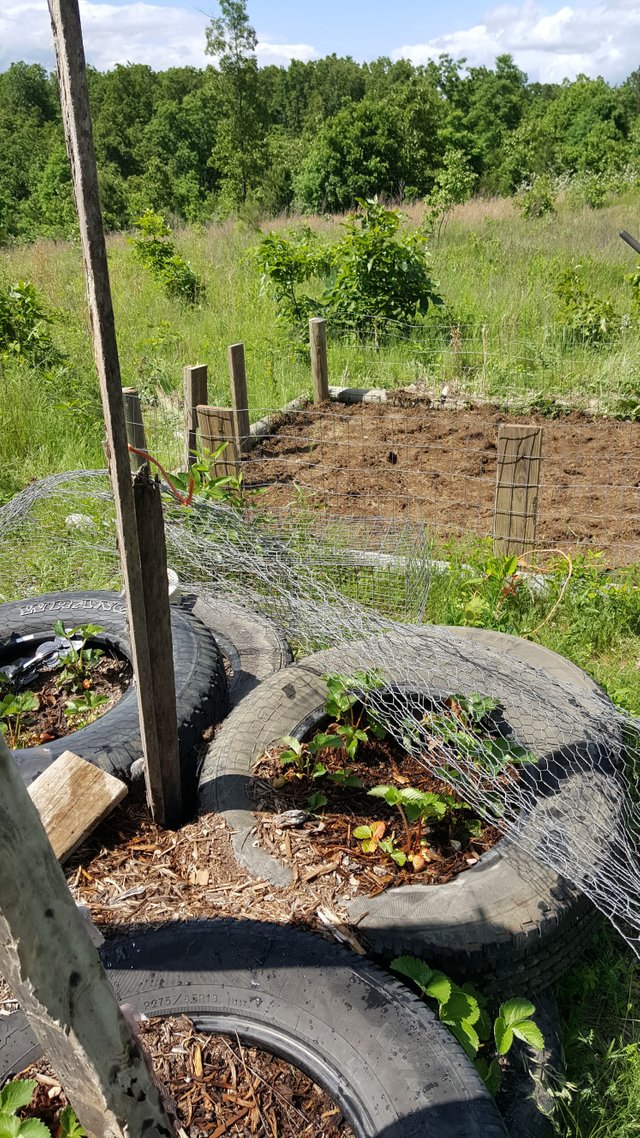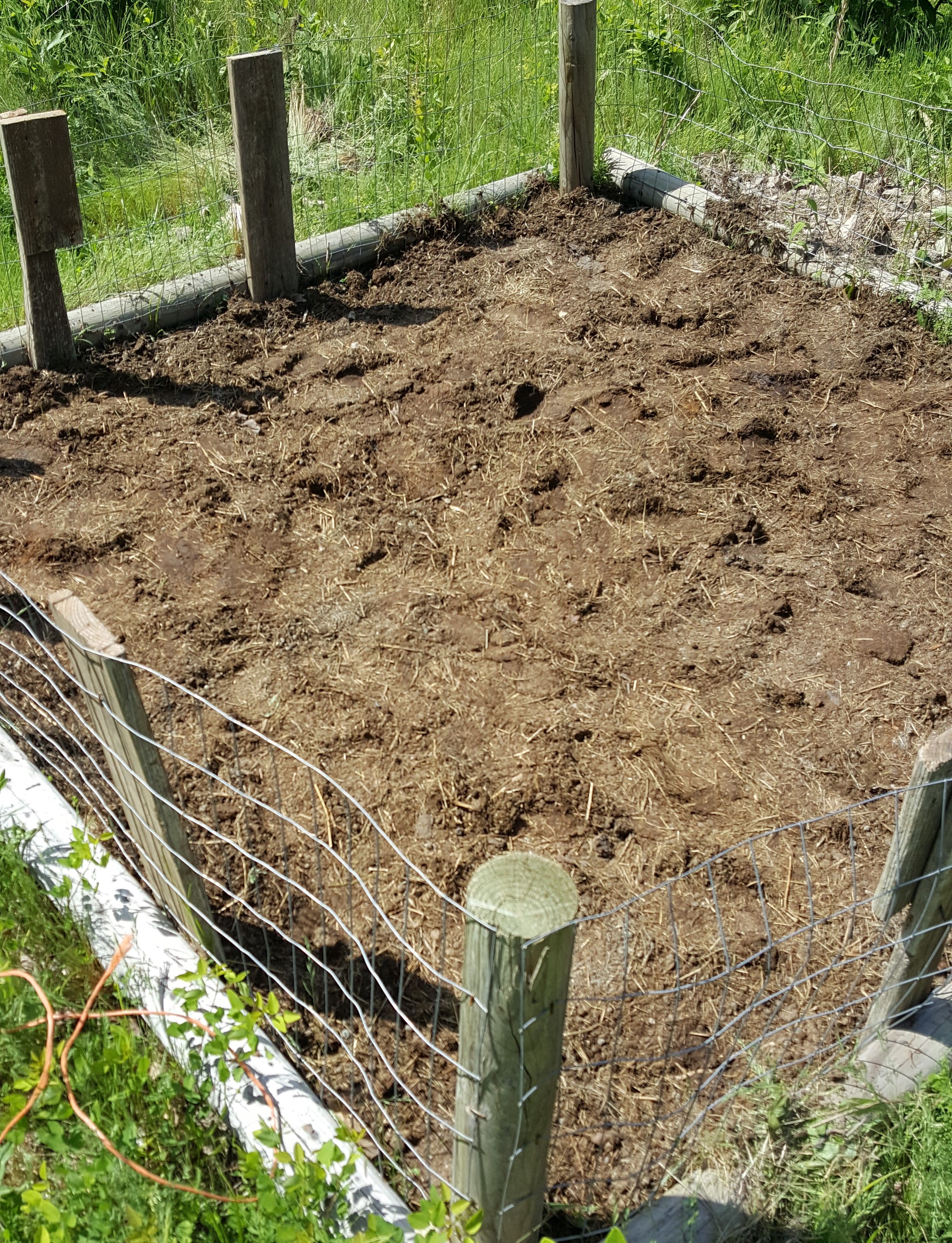My Part In The "One Straw Revolution"
After reading about the "One Straw revolution" I decided that I could Do my part in a different way. Since the land here is hostile, all clay and rock, I am using the rabbit poop, I have, to build a base and level the ground.
.jpg)
- Build a 7x7 rabbit pen.
- I then let the rabbits mow down and provide a base of manure and fertilizer.
- After the rabbits are done, I remove them back to their pens.
- I remove the roof and leave the sides there.
- I clean the rocks and weeds out of the area in the pen.
- Rake the area and loosen the soil and also to remove the rocks that have become loose.
- fill the area and level off with rabbit poop, how deep depends on the crop.
- Water.
- Sow the entire area with clover.
- In this case, I have sown four rows, 1 chia, 2 spinach, 1 lettuce.
When the clover grows, it will grow over the entire area, it is the perfect green manure and mulch. It will also quickly root and keep the remains of the weeds from growing. The spinach will root a little slower than the clover but will have stronger shallow roots and a deep taproot that can penetrate the clay and absorb the moisture deep in the ground.

Since the placement of the crop is specific to the plans, the plot is full sun all day. These greens will flourish. At the end of the season, I will plant winter rye or radishes for a cover crop.
.jpg)
Before I seed the cover crop, I will again place rabbits in the area to mow the clover and add more manure and fertilizer directly on the ground. This will quickly add nitrogen to the soil along with trace ammonia for the next germination.
If I choose rye, it has root systems that will go down about 3 feet, this means it does not have to penetrate so much clay, but while doing that it will loosen the soil underneath, through root mulching, and force rocks up then back down, building the soil depth over all. The remaining grass will be mowed at the end of the season and placed to much after the rye is removed and stored for next year and as a grain that can be fed to the rabbits and chickens. Once the grass mulch is down I will release the rabbits once again and let them feast, preparing the bed for another crop.
Radish will be an edible cover crop where the greens make perfect manure and builds the topsoil. Though the roots will not penetrate deep, they will build a great mulch bed and can be harvested once per month, leaving four to five months of leaf mulch for the rabbits to enjoy. and build a hefty layer of top soil. Though the radish method requires more work, it is well worth the extra labor to harvest radish all winter long and increase to strength and depth of the topsoil
The following crop of clover, chia, spinach and lettuce will be seeded right on top of the mulch, with no need to till. The soil will be in a constant state of breaking down and none of the soil nutrients will be destroyed, in fact there will be an abundance of nutrients in the soil when you consider the all the breaking down of the manure and the worms as well as the beneficial bugs it will attract and maintain.
The abundance of beneficial bugs will counter the bad bugs. The constant harvest of the greens will keep certain bugs from laying eggs the others will be taken care of most part through the beneficial bugs that will be attracted to a very balanced system. These crops will remain growing here for at least 3 years, and probably for about 5 years. At which point I will rotate crops.
.jpg)
Now, each crop will be grown in a 7x7 area in the same manner. The rocks which I clean out are placed in the center between the plots, this allows erosion of the rocks along with the constant feed of the minerals into the soil. Nothing is removed, only moved. The use of companion planting will balance the area's ability to produce. It will be in a constant state of transition and nutrient building. This method not only builds the soil, it helps with water retention, keeping beneficial bugs around, attraction of certain pollinators, and aids in the removal of rocks.
Through the building of this growing method, I am using my pathway in and out with the truck as a future garden area. Since I had to clean out the area for the truck to get in, I used the most beneficial path and will be able to set 2 to 3 more gardens in the case that vehicles are no longer used for a period of time. Adding the area in such a way that it can be used in case of an extended time of being home-bound, gives me the ability to increase garden and specific crop production. In the case that we are stuck here on this ridge for an extended period, I will be growing food for quite a few people. We will all be growing food and providing animals for slaughter. We have, pig, rabbit, chicken, eggs, cow, milk, goats, goat milk, gardens and horses.
The ability to grow without tilling will leave a huge amount of time to shift toward husbandry, since it will increase instantly. In my current garden, I have dubbed my laboratory, I have been testing the hugle cultre gardening method, straw, and hay bale gardening. Each have their pros and cons. The hugle cultres will be better next year as the majority of the stuff I packed it with has broken down. The straw bales favor certain types of food, such as spinach and root crops. Hay bales are worthless, as they mulch quickly and start to fall apart even with the ties still on. Though I will devote one bed for growing hay, as a constant feeder for the rabbits.
As you can see the opportunities are endless. By keeping the plots separated in their own mini ecosystem I can control the soil so it benefits those specific plants at all times. There will of course be certain crops I will need to keep away from other crops, but in general these plots will be used for beans, grains and other large quantity crops we will need.
Each plot or bed will be self sustaining, I will figure out good ways to companion plant each major crop, I have a database of companion planting. This list is also on 3x5s for long term reference. I will also be building a water tower in the field so that each garden area has its own watering system. I have a ram pump I will use to transfer water from the laboratory tower to the field tower once the driving area is not used. Most of the piping will be pex and it will be buried to avoid freezing and damage.
As the field progresses I will post advances. By next week I will have my first garden update as well. We have been collecting strawberries, 2 types of kale, lettuce, cilantro, parsley, and radishes. The Progression of my herb garden as well. Till then remember to cover up and keep the sunning to a minimum, but get some sun.
Well please up-vote and follow if you like my content. I will continue to post similar articles on plants, homegrown foods, gardening and homesteading ideas. Again thanks for dropping in. Remember that this is not medical advice nor do I prescribe anything to anyone. This post is for educational purposes only. Your body is your temple, treat it well. Have a great garden!

Community Forums
I used clover for cover crop last year, as the drought the year before cut severely the available hay for mulch. Once the clover reached a certain height and the plants got so big, I was unable to stay on top of the weeds and the huge are was a horrible mess.
I have used clover cover crop before due to mulch shortage, but this was the worst mess! So don't count on it stopping weeds well, unless you pull the weeds.
Just about everything you see green here (except leeks in foreground) are volunteers or weeds gone wild. With the soil balanced, things do really well, and that includes weeds.
Weeds are a conundrum for most people. But as I walk around in my yard, I find plants that are edible, beautiful and useful. But I totally get how you feel. I work on removing the non-native stuff, for now. And I have a particularly nasty one: Lesser Celandine. Then, there's dead nettle, from Europe and Asia, and jewelweed, which is native to the northeast, but it goes crazy. I keep a hedge of it for the hummingbirds and pollinators, but remove the rest.
Image: Ohio State University.
But this is off the topic. If you have only native "weeds", (as I understand that book), your garden should be able to thrive among them if you prepare the field as the author explained, with minimal work, no tilling, just mulching with straw and cover crops. It's the idea of co-habitation, I guess. The book has a spiritual element, (not religion), more like oneness with everything, and working together.
I have lesser celandine here, but it's not been too much of a problem. I like its bright yellow color in the spring. I also have dead nettle, and the trailing variety has caused more problems than the upright one. And jewelweed, well jewelweed is supposed to grow in the vicinity of poison ivy, as it is an antidote. We have poison ivy and we have jewelweed, but it's not much of a problem either.
The plants that were problems were dock and a few I don't know the names of, but have been contending with for years. I don't mind the weeds in the yard, in fact, there are more weeds than grass in my yard. But I don't want them taking over the veg garden like they did last year, with the connivance of the clover cover crop!
After reading The One Straw Revolution I am ok with the weeds. It is a balance, by keeping the beds small I can keep up with the weeds that will harm plant growth and I can grow dense. I even considered 3x3 but those would be far to much expenditure for little gain. The big change will take some time as the soil and the bed adjust year after year, weeds will grow but the food and clover will keep the majority of the weeds from the area. Also, hay is one of the worst to mulch with since it is loaded with seed, I learned this the hard way. I think it will provide a great way to grow a balanced system. I will also be trying to seed my veggies well before the last freeze, which worked well with me for certain crops this year in the laboratory. PEACE and LOVE to you two. I can't wait to get out there to help!! I will be sending you an email later today or tomorrow.
I've been using hay since 1993, and it may be loaded with seed, but put down properly, there are NO weeds.
I'll be looking for your e-mail!
You better teach me that trick because I wind up with grass every time... I'm hoping to make time tonight and read your hay post... I have been slacking
Here ya go:
https://steemit.com/gardening/@goldenoakfarm/about-using-hay-for-mulch
and if you come to visit, you can see first hand how it works.
Wow! That looks really good! Might have to try some of that!
I have read a lot on certain gardening techniques, companion planting and water. So far, the book The One Straw Revolution has tied together so many of the ideas I have. I have been searching for the best method, low labor, high yield, and natural way to grow food. If this, proven method, works here, I believe I can help those homesteaders around me increase their crop yield without the insane amount of money that they are already spending.
Excellent post - very interesting, and informative.
You could turn your little city house into a mini food forest. Without the need to bring in a machine you could have an abundance of food. 3 rabbits and a some seeds and within a year you would be swimming in food. I guess as long as the neighbors wouldn't shoot you for a rabbit and a carrot, lol.
Derek, I'm happy to see you working with "One Straw Revolution"! It's a question of symbiosis, connectedness, and using the land without destroying it or even disturbing it. Good luck!!!